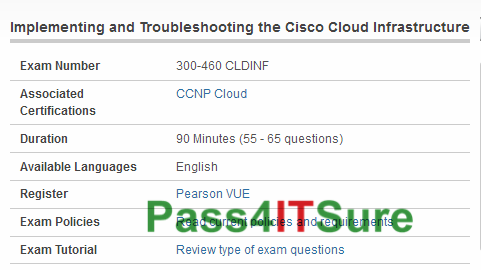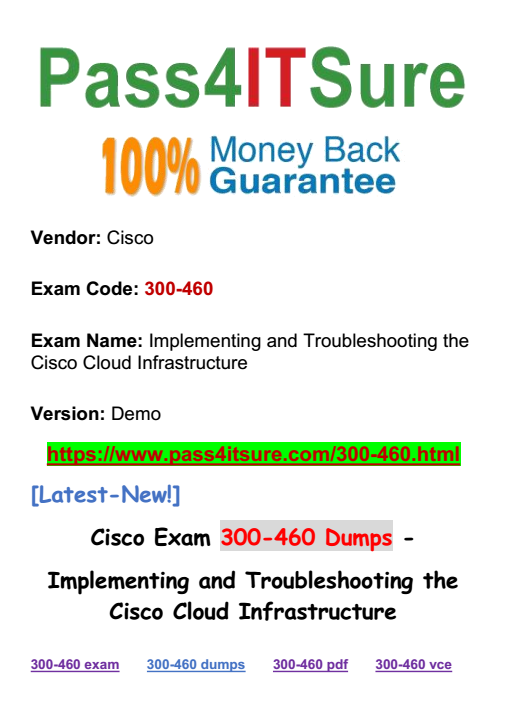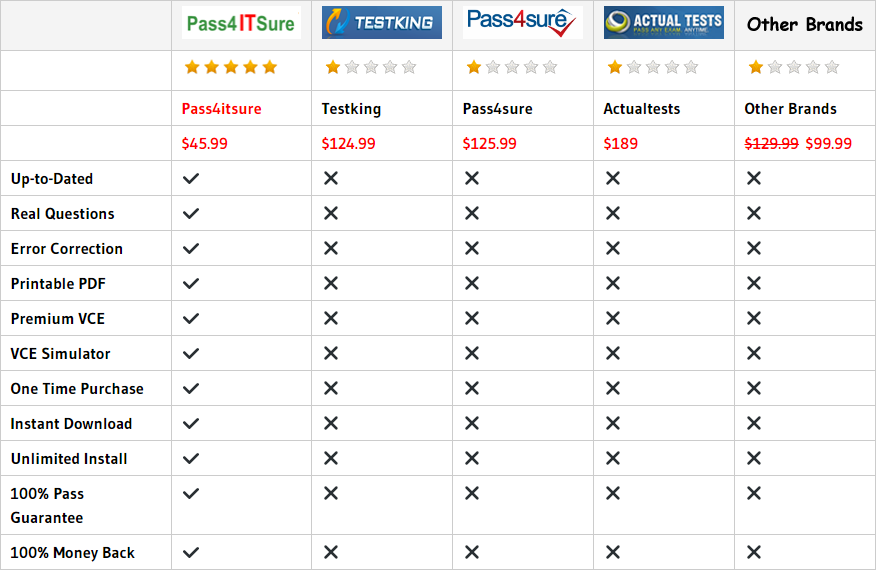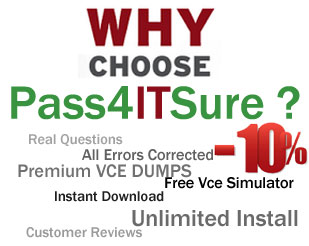
Need the newest Cisco 300-460 exam dumps? Get prepare yourself for latest upload pass4itsure Cisco 300-460 dumps CLDINF exam Youtube study material online. The “Implementing and Troubleshooting the Cisco Cloud Infrastructure” certification 300-460 dumps exam verifies that the candidate possesses the deep knowledge required in the area of CCNP Cloud. Pass4itsure 300-460 training material is best source which provides latest 300-460 dumps test questions. This certificate proves that the candidate has an advanced understanding to setup Cloud infrastructure including physical and virtual Data Centers;to implement Storage infrastructure and connectivity;to implement Network infrastructure and connectivity;to implement Compute;troubleshoot Cloud workflows or applications;identify infrastructure operational domains and is able to apply these skills practically and provide guidance in https://www.pass4itsure.com/300-460.html dumps Cisco Cloud Infrastructure (CLDINF v1.0) course.
Here are some preparation tips that you should keep in mind while preparing Cisco 300-460 exam:
- Prepare exam topics according to the updated syllabus of Cisco 300-460 exam.
- Get Most authentic Exam preparation material.
- Know Exam criteria (Questions, Types, Time duration, difficulty level etc).
- Get hands on practice test software before appearing in Cisco 300-460 exam.

Kill your exam with Cisco 300-460 dumps real questions(1-12)
1. The following JSP uses tags to access SAS data: <%@taglib uri=”http://www.sas.com/taglib/sasads” prefix=”sasads”%> data report; set db.payroll (obs=10); where division=’EUROPE’; run; proc print data=report; /body>Which of the following explains why no results are displayed?
A. The SAS program contains a syntax error.
B. The SAS program is missing a step boundary.
C. The Connection Custom Tag syntax is incorrect.
D. The open Submit Custom Tag syntax is incorrect.
300-460 exam Answer: B
2. A SAS program named printProcedure contains a macro variable named numObs. A JSP file includes: a form with a choice box control named number that contains numeric values that are used to specify the number of observations printed in the report a Submit Custom Tag that submits the SAS program named printProcedure. Which of the following JSP code segments retrieves the value selected in the choice box and assigns it to the macro variable?
I. %let numObs=<%=request.getParameter(“number”)%>; %include ‘c:\printProcedure.sas’;
II. <% String selObs=request.getParameter(“number”); %> %let numObs=<%=selObs%>; %include ‘c:\printProcedure.sas’;
III. <% String selObs=request.getParameter(“number”); %> %let numObs=selObs; %include ‘c:\printProcedure.sas’;
IV. <% String selObs=request.getParameter(“number”); %> %let numObs=&selObs; %include ‘c:\printProcedure.sas’;
A. I only
B. III only
C. I and II only
D. III and IV only
Answer: C
3. Which of the following describes viewing the detailed data behind a specific data cell in a SAS MDDB?
A. Expand
B. Subset
C. Drill down
D. Reach-through
300-460 dumps Answer: D
4. Click on the Exhibit button to display an entity-relationship data model for a stock broker program. The data model needs to be optimized for queries to gather a customer’s net worth on a given day. The broker has two customers holding stock in several hundred different companies. Daily pricing history goes back ten years for each company. Which one of the following index schemes allows optimal performance of the query?
A. composite index on cusip and date in the Prices table composite index on cusip and trandate in the Transaction table
B. composite index on cusip and date in the Prices table composite index on cust_name, cusip, and trandate in the Transaction table
C. simple index on cusip in the Prices table simple index on date in the Prices table composite index on cusip and trandate in the Transaction table
D. composite index on date and cusip in the Prices table simple index on cusip in the Transaction table simple index on trandate in the Transaction table
Answer: C
5. Which of the following are advantages of using JavaScript on an HTML form?
I. It can implement client-side validation.
II. It can implement server-side validation.
III. It can implement data security on the form.
IV. It can enable a submit request without needing a submit button.
A. I and IV only
B. II and IV only
C. I, III, and IV
D.II, III, and IV
300-460 pdf Answer: A
6. Assume that an application must move to another resource. It must also prevent access to the current request and response objects. Which of the following methods satisfies the above requirement?
A. the response object’s forward() method
B. the response object’s sendRedirect() method
C. the RequestDispatcher object’s include() method
D. the RequestDispatcher object’s forward() method
Answer: B
7. Assume a connection to SAS exists. The following JSP code is executed: <%@taglib uri=”http://www.sas.com/taglib/sasads” prefix=”sasads”%> options nodate nonumber; proc print data=sashelp.shoes(obs=5); title1 ‘Partial listing of the SHOES data set’; run; Click the Exhibit button to view the resulting output. Which of the following modifications to the second Submit Custom Tag in the JSP would produce the output shown in the exhibit?
A.
B.
C.
D.
300-460 vce Answer: B
8. Which of the following are ways to configure an IOM Bridge Server?
I. using an LDAP server
II. using configuration files
III. using an IOMConfiguration object
IV. embedding server information in the application
A. I and II only
B. II and III only
C. I, II and IV only
D. I, II, III and IV
Answer: C
9. An application has the following requirements: The number of users is likely to grow rapidly. There is a large number of users across multiple locations. The application is dynamic and requires updates to be propagated quickly and easily. There are a wide variety of client machines utilizing different hardware and software platforms. Which of the following technologies satisfies the above requirements?
A. Java applet
B. Java application
C. SAS/AF application
D. Server-side Java application
300-460 exam Answer: D
10. Which of the following statements is true about object-orientation in Java?
A. An abstract class can not be subclassed.
B. Subclasses can only use attributes and methods inherited from the parent class.
C. A class that is toward the bottom of the class hierarchy is a generic, non-specialized class.
D. Subclasses start out with the protected attributes and methods inherited from the parent class.
Answer: D
11. Service A is an entity service with a functional context dedicated to invoice-related processing. Service B is a utility service that provides generic data access to a database. In this service composition architecture, Service Consumer A sends a SOAP message containing an invoice XML document to Service A(1). Service A then sends the invoice XML document to Service B (2), which then writes the invoice document to a database. The data model used by Service Consumer A to represent the invoice document is based on XML Schema A. The service contract of Service A is designed to accept invoice documents based on XML Schema B. The service contract for Service B is designed to accept invoice documents based on XML Schema A. The database to which Service B needs to write the invoice record only accepts entire business documents in Comma Separated Value (CSV) format. Due to the incompatibility of the XML schemas used by the services, the sending of the
invoice document from Service Consumer A through to Service B cannot be accomplished using the services as they currently exist. Assuming that the Contract Centralization pattern is being applied and that the Logic Centralization is not being applied, what steps can be
taken to enable the sending of the invoice document from Service Consumer A to the database without adding logic that will increase the runtime performance requirements of the service composition?
A. Service Consumer A can be redesigned to use XML Schema B so that the SOAP message it sends is compliant with the service contract of Service A . The Data Model Transformation pattern can then be applied to transform the SOAP message sent by Service A so that it conforms to the XML Schema A used by Service B. The StandardizedService Contract principle must then be applied to Service B and Service Consumer A so that the invoice XML document is optimized to avoid unnecessary validation.
B. The service composition can be redesigned so that Service Consumer A sends the invoice document directly to Service B. Because Service Consumer A and Service B use XML Schema A, the need for transformation logic is avoided. This naturally applies the Service Loose Coupling principle because Service Consumer A is not required to send the invoice document in a format that is compliant with the database used by Service B.
C. Service Consumer A can be redesigned to write the invoice document directly to the database. This reduces performance requirements by avoiding the involvement of Service A and Service B . It further supports the application of the Service Abstraction principle by ensuring that Service Consumer A hides the details of the data access logic required to write to the database.
D. None of the above.
300-460 dumps Answer: B
Explanation:
12.Service A is an entity service with a functional context dedicated to invoice-related processing. Service B is a utility service that provides generic data access to a database. In this service composition architecture, Service Consumer A sends a SOAP message containing an invoice XML document to Service A(1). Service A then sends the invoice XML document to Service B (2), which then writes the invoice document to a database. The data model used by Service Consumer A to represent the invoice document is based on XML Schema A. The service contract of Service A is designed to accept invoice documents based on XML Schema B. The service contract for Service B is designed to accept invoice documents based on XML Schema A. The database to which Service B needs to write the invoice record only accepts entire business documents in Comma Separated Value (CSV) format. Due to the incompatibility of XML schemas used by the services, the sending of the invoice document from Service Consumer A through to Service B cannot be accomplished using the services as they currently exist. Assuming that the Contract Centralization and Logic Centralization patterns are being applied, what steps can be taken to enable the sending of
the invoice document from Service Consumer A to the database without adding logic that will increase the runtime performance of the service composition?
A. The Data Model Transformation pattern can be applied so that the invoice document sent by Service Consumer A is transformed into an invoice document that is compliant with the XML Schema B used by Service A . The Data Model Transformation pattern can be applied again to ensure that the invoice document sent by Service A is compliant with XML Schema A used by Service B.
B. The service composition can be redesigned so that Service Consumer A sends the invoice document directly to Service B. Because Service Consumer A and Service B use XML Schema A, the need for transformation logic is avoided. This naturally applies the Service Loose Coupling principle because Service Consumer A is not required to send the invoice document in a format that is compliant with the database used by Service B.
C. The Standardized Service Contract principle can be applied to the service contract of Service A so that it is redesigned to use XML Schema A. This would make it capable of receiving the invoice document from Service Consumer A and sending the invoice document to Service B without the need to further apply the Data Model Transformation pattern.
D. None of the above.
Answer: C
Explanation:

See What Our Customers Are Saying:
We at Pass4itsure are committed to our customer’s success. It doesn’t matter where an Implementing and Troubleshooting the Cisco Cloud Infrastructure (CLDINF) exam student belongs to, the CLDINF 300-460 questions and answers have always been really very important for the CCNP Cloud professionals who want to pass CLDINF 300-460 dumps exam. Our Cisco 300-460 dumps are created with utmost care and professionalism. We utilize the experience and knowledge of a team of industry professionals from leading organizations all over the world.

Here you can download free practice tests 300-460 dumps: Implementing and Troubleshooting the Cisco Cloud Infrastructure. The Cisco 300-460 exam dumps has been helping the Cisco certified professionals for the preparation of Implementing and Troubleshooting the Cisco Cloud Infrastructure (CLDINF) exam. The Implementing and Troubleshooting the Cisco Cloud Infrastructure (300-460 CLDINF) exam is a 90-minute, 45–55 question assessment that is associated with the associated with the CCNP Cloud certification, which covers all objectives of (Implementing and Troubleshooting the Cisco Cloud Infrastructure).
[Up To Dated -2018 Cisco 300-460 Dumps From Google Drive]: https://drive.google.com/open?id=1Z-ds38s_90wG5y0AgdzkdBdd0ukz50qC
[Up To Dated -2018 Cisco 300-550 Dumps From Google Drive]: https://drive.google.com/open?id=10DTg9-VFQRba3WcAGQZLOvnJ8Msj-jKQ
Compared with other brands, Pass4itsure has up to dated exam information, affordable price, instant exam PDF files downloaded, error correction, unlimited install,etc. This is the reason almost every Implementing and Troubleshooting the Cisco Cloud Infrastructure (CLDINF) exam candidate like to get Cisco 300-460 dumps training material from Pass4itsure and appeared confidently for the Cisco 300-460 exam in just first attempt. Such as Pass4itsure Cisco 300-460 Dumps Demo, Latest Upload Cisco 300-460 Dumps Certification Material Online, We Help You Pass Implementing and Troubleshooting the Cisco Cloud Infrastructure.
